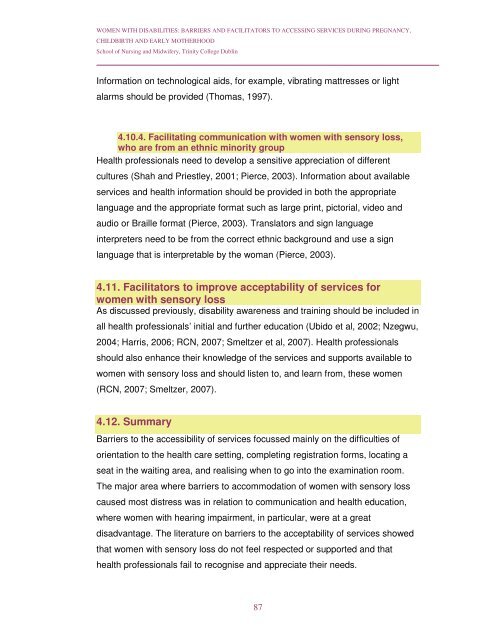Women with Disabilities: Barriers and Facilitators to Accessing ...
Women with Disabilities: Barriers and Facilitators to Accessing ...
Women with Disabilities: Barriers and Facilitators to Accessing ...
You also want an ePaper? Increase the reach of your titles
YUMPU automatically turns print PDFs into web optimized ePapers that Google loves.
WOMEN WITH DISABILITIES: BARRIERS AND FACILITATORS TO ACCESSING SERVICES DURING PREGNANCY,CHILDBIRTH AND EARLY MOTHERHOODSchool of Nursing <strong>and</strong> Midwifery, Trinity College DublinInformation on technological aids, for example, vibrating mattresses or lightalarms should be provided (Thomas, 1997).4.10.4. Facilitating communication <strong>with</strong> women <strong>with</strong> sensory loss,who are from an ethnic minority groupHealth professionals need <strong>to</strong> develop a sensitive appreciation of differentcultures (Shah <strong>and</strong> Priestley, 2001; Pierce, 2003). Information about availableservices <strong>and</strong> health information should be provided in both the appropriatelanguage <strong>and</strong> the appropriate format such as large print, pic<strong>to</strong>rial, video <strong>and</strong>audio or Braille format (Pierce, 2003). Transla<strong>to</strong>rs <strong>and</strong> sign languageinterpreters need <strong>to</strong> be from the correct ethnic background <strong>and</strong> use a signlanguage that is interpretable by the woman (Pierce, 2003).4.11. <strong>Facilita<strong>to</strong>rs</strong> <strong>to</strong> improve acceptability of services forwomen <strong>with</strong> sensory lossAs discussed previously, disability awareness <strong>and</strong> training should be included inall health professionals’ initial <strong>and</strong> further education (Ubido et al, 2002; Nzegwu,2004; Harris, 2006; RCN, 2007; Smeltzer et al, 2007). Health professionalsshould also enhance their knowledge of the services <strong>and</strong> supports available <strong>to</strong>women <strong>with</strong> sensory loss <strong>and</strong> should listen <strong>to</strong>, <strong>and</strong> learn from, these women(RCN, 2007; Smeltzer, 2007).4.12. Summary<strong>Barriers</strong> <strong>to</strong> the accessibility of services focussed mainly on the difficulties oforientation <strong>to</strong> the health care setting, completing registration forms, locating aseat in the waiting area, <strong>and</strong> realising when <strong>to</strong> go in<strong>to</strong> the examination room.The major area where barriers <strong>to</strong> accommodation of women <strong>with</strong> sensory losscaused most distress was in relation <strong>to</strong> communication <strong>and</strong> health education,where women <strong>with</strong> hearing impairment, in particular, were at a greatdisadvantage. The literature on barriers <strong>to</strong> the acceptability of services showedthat women <strong>with</strong> sensory loss do not feel respected or supported <strong>and</strong> thathealth professionals fail <strong>to</strong> recognise <strong>and</strong> appreciate their needs.87
















